Quantitative Assessment of Cold Injury in Tea Plants by Terahertz Spectroscopy Method
Abstract
1. Introduction
2. Materials and Methods
2.1. Samples Preparation
2.2. THz Spectra Detection and Assessment of the CI
2.3. Signal Processing of THz Waveform
2.4. Computation of 2D Correlation Spectroscopy
2.5. Evaluation of Models’ Performance
3. Results and Discussion
3.1. Absorbance Response of Tea Leaves to Different Low Temperatures
3.2. Multivariate Analysis Using the AI–PLSR and 2DCOS–PLSR Models
3.2.1. The Role of Outliers in the Model
3.2.2. Average Intensity (AI) Spectra and Synchronous 2DCOS
3.2.3. Performance Evaluation of the Models
4. Conclusions
Author Contributions
Funding
Data Availability Statement
Acknowledgments
Conflicts of Interest
References
- Li, X.; Sun, C.; Luo, L.; He, Y. Determination of tea polyphenols content by infrared spectroscopy coupled with iPLS and random frog techniques. Comput. Electron. Agric. 2015, 112, 28–35. [Google Scholar] [CrossRef]
- Cheng, T.O. Will green tea be even better than black tea to increase coronary flow velocity reserve? Am. J. Cardiol. 2004, 94, 12–23. [Google Scholar] [CrossRef] [PubMed]
- Hacker, J.; Ladinig, U.; Wagner, J.; Neuner, G. Inflorescences of alpine cushion plants freeze autonomously and may survive subzero temperatures by super cooling. Plant Sci. 2011, 180, 149–156. [Google Scholar] [CrossRef] [PubMed]
- Skupien, J.; Wojtowicz, J.; Kowalewska, L.; Mazur, R.; Garstka, M.; Gieczewska, K.; Mostowska, A. Dark-chilling induces substantial structural changes and modifies galactolipid and carotenoid composition during chloroplast biogenesis in cucumber (Cucumissativus L.) cotyledons. Plant Physiol. Biochem. 2017, 111, 107–118. [Google Scholar] [CrossRef]
- Asante, E.; Du, Z.; Lu, Y.; Hu, Y. Detection and assessment of nitrogen effect on cold tolerance for tea by hyperspectral reflectance with PLSR, PCR, and LM models. Inf. Process. Agric. 2021, 8, 96–104. [Google Scholar] [CrossRef]
- Lu, Y.; Hu, Y.; Zhao, C.; Snyder, R.L. Modification of water application rates and intermittent control for sprinkler frost protection. Trans. ASABE 2018, 61, 1277–1285. [Google Scholar] [CrossRef]
- Lu, Y.; Hu, Y.; Snyder, R.L.; Kent, E.R. Tea leaf’s microstructure and ultrastructure response to low temperature in indicating critical damage temperature. Inf. Process. Agric. 2019, 6, 247–254. [Google Scholar] [CrossRef]
- Hu, Y.; Amoah Asante, E.; Lu, Y.; Mahmood, A.; Ali Buttar, N.; Yuan, S. A review of air disturbance technology for plant frost protection. Int. J. Agric. Biol. Eng. 2018, 11, 21–28. [Google Scholar] [CrossRef]
- Lu, Y.Z.; Hu, Y.G.; Zhang, X.L.; Li, P.P. Responses of electrical properties of tea leaves to low-temperature stress. Int. J. Agric. Biol. Eng. 2015, 8, 170–175. [Google Scholar]
- Taschler, D.; Neuner, G. Summer frost resistance and freezing patterns measured insitu in leaves of major alpine plant growth forms in relation to their upper distribution boundary. Plant Cell Environ. 2004, 27, 737–746. [Google Scholar] [CrossRef]
- Skinner, D.Z.; Garland-Campbell, K.A. The relationship of LT50 to prolonged freezing survival in winter wheat. Can. J. Plant Sci. 2008, 88, 885–889. [Google Scholar] [CrossRef]
- Gusta, L.V.; O’Connor, B.J.; Gao, Y.P.; Jana, S. Are-evaluation of controlled freeze-tests and controlled environment hardening conditions to estimate the winter survival potential of hardy winter wheats. Can. J. Plant Sci. 2001, 81, 241–246. [Google Scholar] [CrossRef]
- Equiza, M.A.; Francko, D.A. Assessment of freezing injury in palm species by chlorophyll Fluorescence. HortScience 2010, 45, 845–848. [Google Scholar] [CrossRef]
- Min, K.; Chen, K.; Arora, R. Effect of short-term versus prolonged freezing on freeze–thaw injury and post-thaw recovery in spinach: Importance in laboratory freeze–thaw protocols. Environ. Exp. Bot. 2014, 106, 124–131. [Google Scholar] [CrossRef]
- Gao, Z.; Li, J.; Zhu, H.; Sun, L.; Du, Y.; Zhai, H. Using differential thermal analysis to analyze cold hardiness in the roots of grape varieties. Sci. Hortic. 2014, 174, 155–163. [Google Scholar] [CrossRef]
- Agarwal, M.; Hao, Y. A R2R3 type MYB3 transcription factor is involved in the cold regulation of CBF genes and in acquired freezing tolerance. J. Biol. Chem. 2006, 281, 37636–37645. [Google Scholar] [CrossRef]
- Halloy, S.R.P.; Gonzalez, J.A. An inverse relation between frost survival and osmotic pressure. Arct. Alp. Res. 1993, 25, 117–123. [Google Scholar] [CrossRef]
- Jördens, C.; Scheller, M.; Breitenstein, B.; Selmar, D.; Koch, M. Evaluation of leaf water status by means of permittivity at terahertz frequencies. J. Biol. Phys. 2009, 35, 255–264. [Google Scholar] [CrossRef]
- Liu, W.; Liu, C.; Hu, X.; Yang, J.; Zheng, L. Application of terahertz spectroscopy imaging for discrimination of transgenic rice seeds with chemometrics. Food Chem. 2016, 210, 415–421. [Google Scholar] [CrossRef]
- Pan, L.; Zhang, Q.; Zhang, W.; Sun, Y.; Hu, P.; Tu, K. Detection of cold injury in peaches by hyperspectral reflectance imaging and artificial neural network. Food Chem. 2016, 192, 134–141. [Google Scholar] [CrossRef]
- Wang, K.; Sun, D.W.; Pu, H. Emerging non-destructive terahertz spectroscopic imaging technique: Principle and applications in the agri-food industry. Trends Food Sci. Technol. 2017, 67, 93–105. [Google Scholar] [CrossRef]
- Mathanker, S.K.; Weckler, P.R.; Wang, N. Terahertz (THz) applications in food and agriculture: A review. Trans. Am. Soc. Agric. Biol. Eng. 2013, 56, 1213–1226. [Google Scholar]
- Walther, M.; Fischer, B.M.; Ortner, A.; Bitzer, A.; Thoman, A.; Helm, H. Chemical sensing and imaging with pulsed terahertz radiation. Anal. Bioanal. Chem. 2010, 397, 1009–1017. [Google Scholar] [CrossRef] [PubMed]
- Hadjiloucas, S.; Karatzas, L.S.; Bowen, J.W. Measurements of leaf water content using terahertz radiation. IEEE Trans. Microw. Theory Tech. 1999, 47, 142–149. [Google Scholar] [CrossRef]
- Wold, S.; Sjostrom, M.; Eriksson, L. PLS-regression: A basic tool of chemometrics. Chemom. Intell. Lab. Syst. 2001, 58, 109–130. [Google Scholar] [CrossRef]
- Hua, Y.; Zhang, H.; Zhou, H. Quantitative determination of cyfluthrin in Nhexane by Terahertz time-domain spectroscopy with chemometrics methods. IEEE Trans. Instrum. Meas. 2010, 59, 1414–1423. [Google Scholar]
- Suzuki, T.; Ogawa, Y.; Kondo, N. Characterization of pesticide residue, cis-permethrin by terahertz spectroscopy, Engineering in Agriculture. Environ. Food 2011, 4, 90–94. [Google Scholar]
- Zhao, X.L.; Li, J.S. Diagnostic techniques of talc powder in flour based on the THz spectroscopy. J. Phys. Conf. Ser. 2011, 276. [Google Scholar] [CrossRef]
- Chen, T.; Li, Z.; Yin, X.; Hu, F.; Hu, C. Discrimination of genetically modified sugar beets based on terahertz spectroscopy. Spectrochim. Acta Part A Mol. Biomol. 2016, 153, 586–590. [Google Scholar] [CrossRef]
- Lu, Y.Z.; Hu, Y.G.; Li, P.P. Consistency of electrical and physiological properties of tea leaves on indicating critical cold temperature. Biosyst. Eng. 2017, 159, 89–96. [Google Scholar] [CrossRef]
- Chan, W.L.; Deibel, J.; Mittleman, D.M. Imaging with terahertz radiation. Rep. Prog. Phys. 2007, 70, 1325–1379. [Google Scholar] [CrossRef]
- Lourenço, N.D.; Lopes, J.A.; Almeida, C.F.; Sarraguça, M.C.; Pinheiro, H.M. Bioreactor monitoring with spectroscopy and chemometrics: A review. Anal. Bioanal. Chem. 2012, 404, 1211–1237. [Google Scholar] [CrossRef]
- Castro-camus, E.; Palomar, M.; Covarrubias, A.A. Leaf water dynamics of Arabidopsis thaliana monitored in vivo using terahertz time-domain spectroscopy. Sci. Rep. 2013, 3, 2910. [Google Scholar] [CrossRef]
- Born, N.; Behringer, D.; Liepelt, S.; Beyer, S.; Schwerdtfeger, M.; Ziegenhagen, B.; Koch, M. Monitoring Plant Drought Stress Response Using Terahertz Time-Domain Spectroscopy. Plant Physiol. 2014, 164, 1571–1577. [Google Scholar] [CrossRef]
- Suhandy, D.; Yulia, M.; Ogawa, Y.; Kondo, N. Prediction of L-Ascorbic Acid using FTIR-ATR Terahertz Spectroscopy Combined with Interval Partial Least Squares (iPLS) Regression. Eng. Agric. Environ. Food 2013, 6, 111–117. [Google Scholar] [CrossRef]
- Pan, T.T.; Sun, D.W.; Cheng, J.H.; Pu, H. Regression algorithms in hyperspectral data analysis for meat quality detection and evaluation. Compr. Rev. Food Sci. Food Saf. 2016, 15, 529–541. [Google Scholar] [CrossRef]
- Zhang, X.C.; Xu, J. THz spectroscopy and imaging. In Introduction to THz Wave Photonics; Springer: New York, NY, USA, 2010; pp. 49–69. [Google Scholar]
- Zhang, H.; Zhi Li, Z.; Tao, T.; Qin, B. Quantitative determination of Auramine O by terahertz spectroscopy with 2DCOS-PLSR model. Spectrochim. Acta Part A Mol. Biomol. Spectrosc. 2017, 184, 335–341. [Google Scholar] [CrossRef]
- Song, F.V.; Yang, B.; Di Tommaso, D.; Donnan, R.S.; Chass, G.A.; Yada, R.Y.; Farrar, D.H.; Tian, K.V. Resolving nanoscopic structuring and interfacial THz dynamics in setting cements. Mater. Adv. 2022, 3, 4982–4990. [Google Scholar] [CrossRef]
- Tian, K.V.; Yang, B.; Yue, Y.; Bowron, D.T.; Mayers, J.; Donnan, R.S.; Dobó-Nagy, C.; Nicholson, J.W.; Fang, D.-C.; Greer, A.L.; et al. Atomic and vibrational origins of mechanical toughness in bioactive cement during setting. Nat. Commun. 2015, 6, 8631. [Google Scholar] [CrossRef]
- Heideman, M.T.; Johnson, D.H.; Burrus, C.S. “Gauss and the history of the fast Fourier transform” (PDF). IEEE ASSP Mag. 1984, 1, 14–21. [Google Scholar] [CrossRef]
- Pedro, A.M.K.; Ferreira, M.M.C. Nondestructive Determination of Solids and Carotenoids in Tomato Products by Near-Infrared Spectroscopy and Multivariate Calibration. Anal. Chem. 2005, 77, 2505–2511. [Google Scholar] [CrossRef] [PubMed]
- Mazarevica, G.; Diewok, J.; Baena, J.; Rosenberg, E.; Lendl, B. On-line fermentation monitoring by mid-infrared spectroscopy. Appl. Spectrosc. 2004, 58, 804–810. [Google Scholar] [CrossRef] [PubMed]
- Groberio, T.S.; Zacca, J.J.; Talhavini, M.; Braga, J.W.B. Quantification of cocaine hydrochloride in seized drug samples by infrared spectroscopy and PLSR. J. Braz. Chem. Soc. 2014, 25, 1696–1703. [Google Scholar] [CrossRef]
- Noda, I. Techniques useful in two-dimensional correlation and codistribution spectroscopy (2DCOS and 2DCDS) analyses. J. Mol. Struct. 2016, 1124, 29–41. [Google Scholar] [CrossRef]
- Noda, I. Generalized 2-dimensional correlation method applicable to infrared, raman, and other types of spectroscopy. Appl. Spectrosc. 1993, 47, 1329–1336. [Google Scholar] [CrossRef]
- Noda, I. Determination of two-dimensional correlation spectra using the Hilbert transform. Appl. Spectrosc. 2000, 54, 994–999. [Google Scholar] [CrossRef]
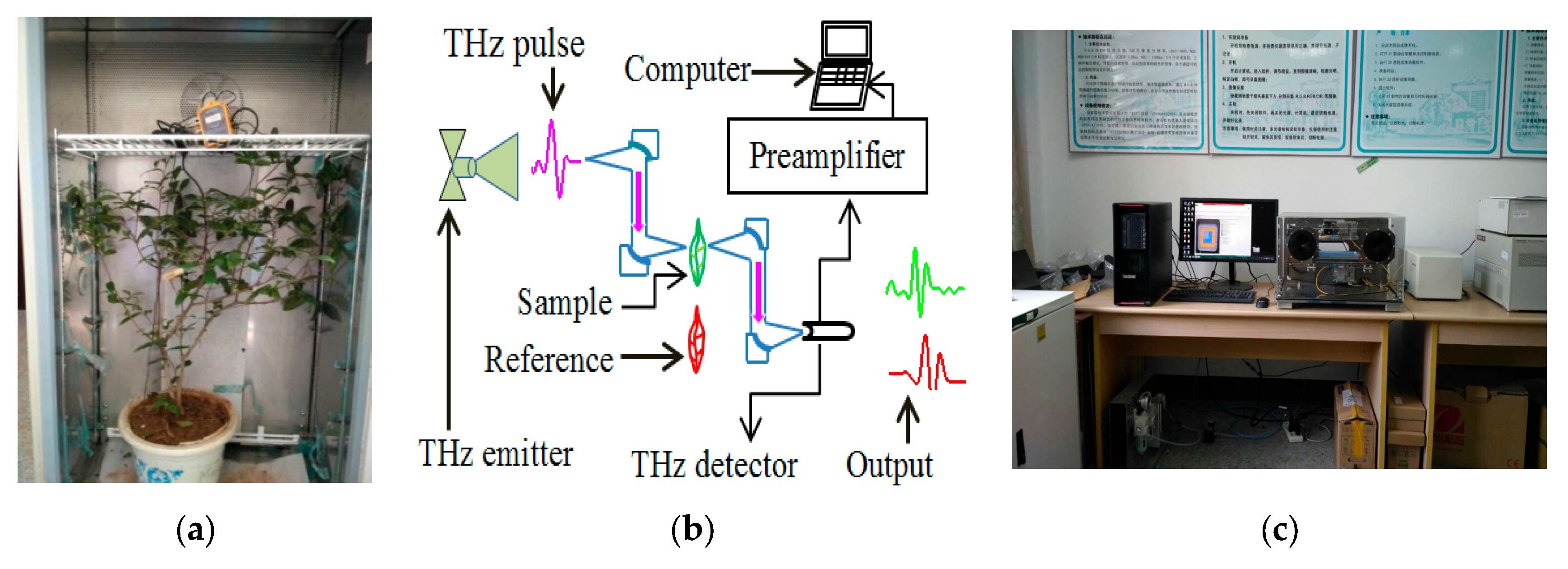
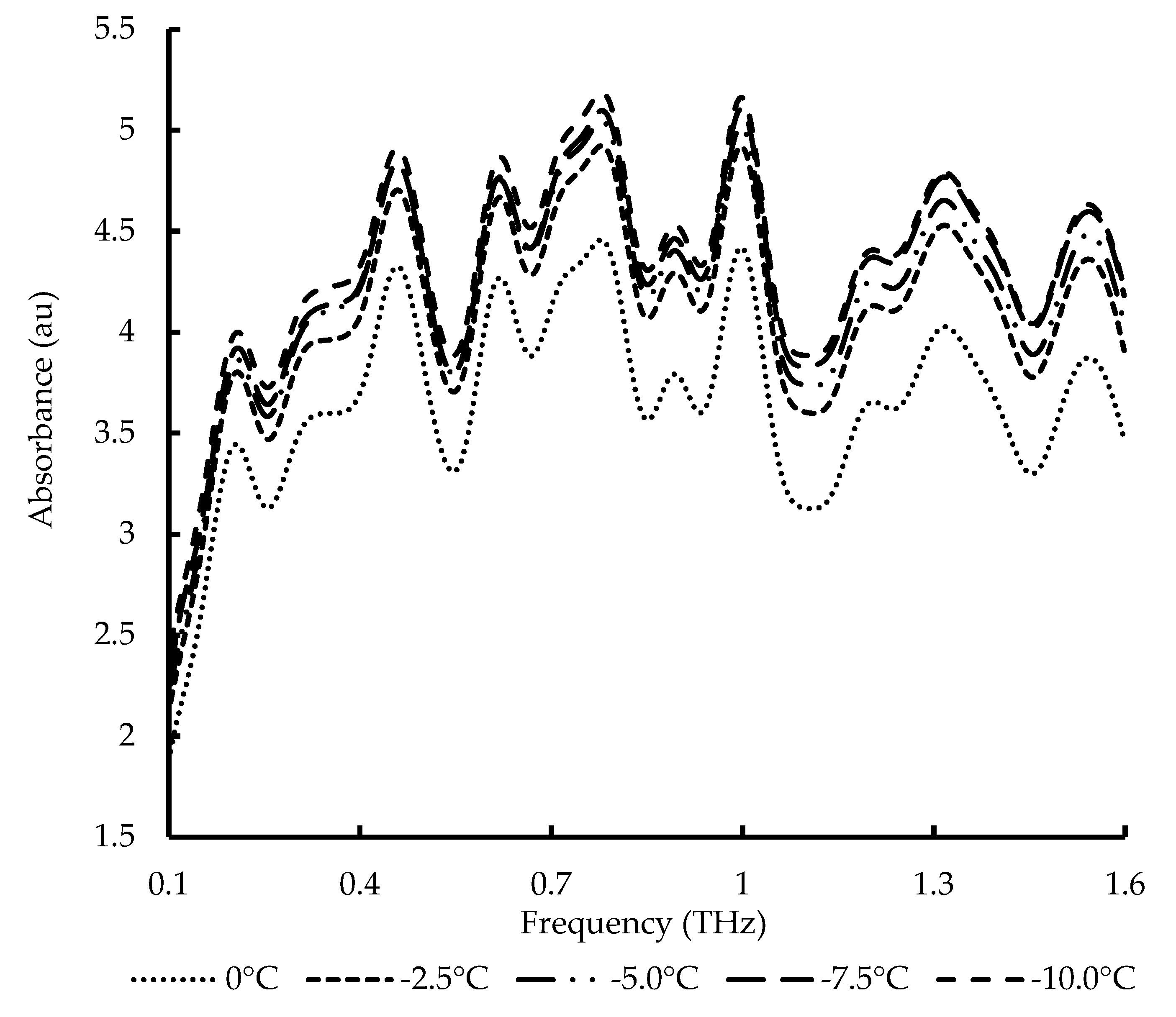

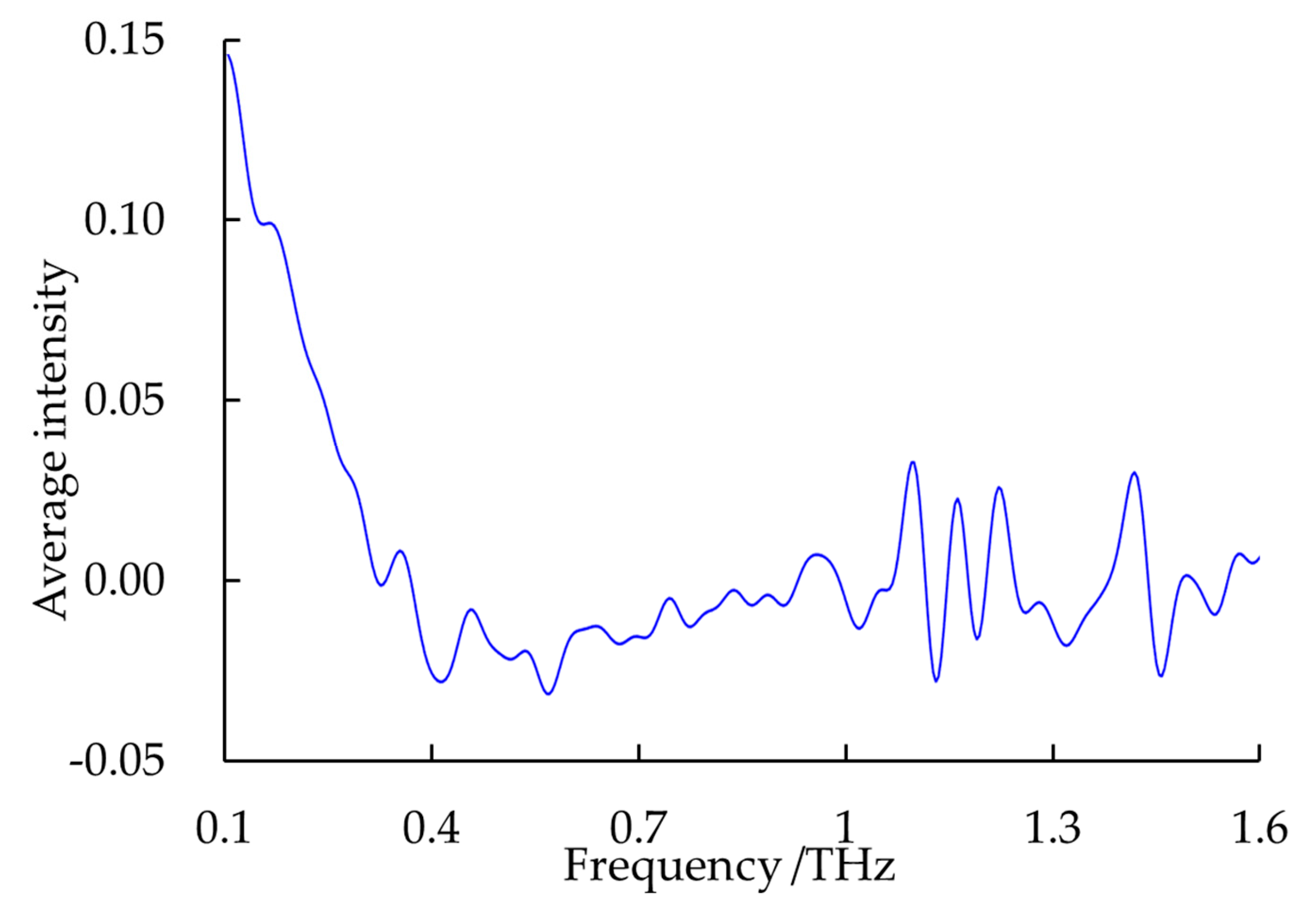
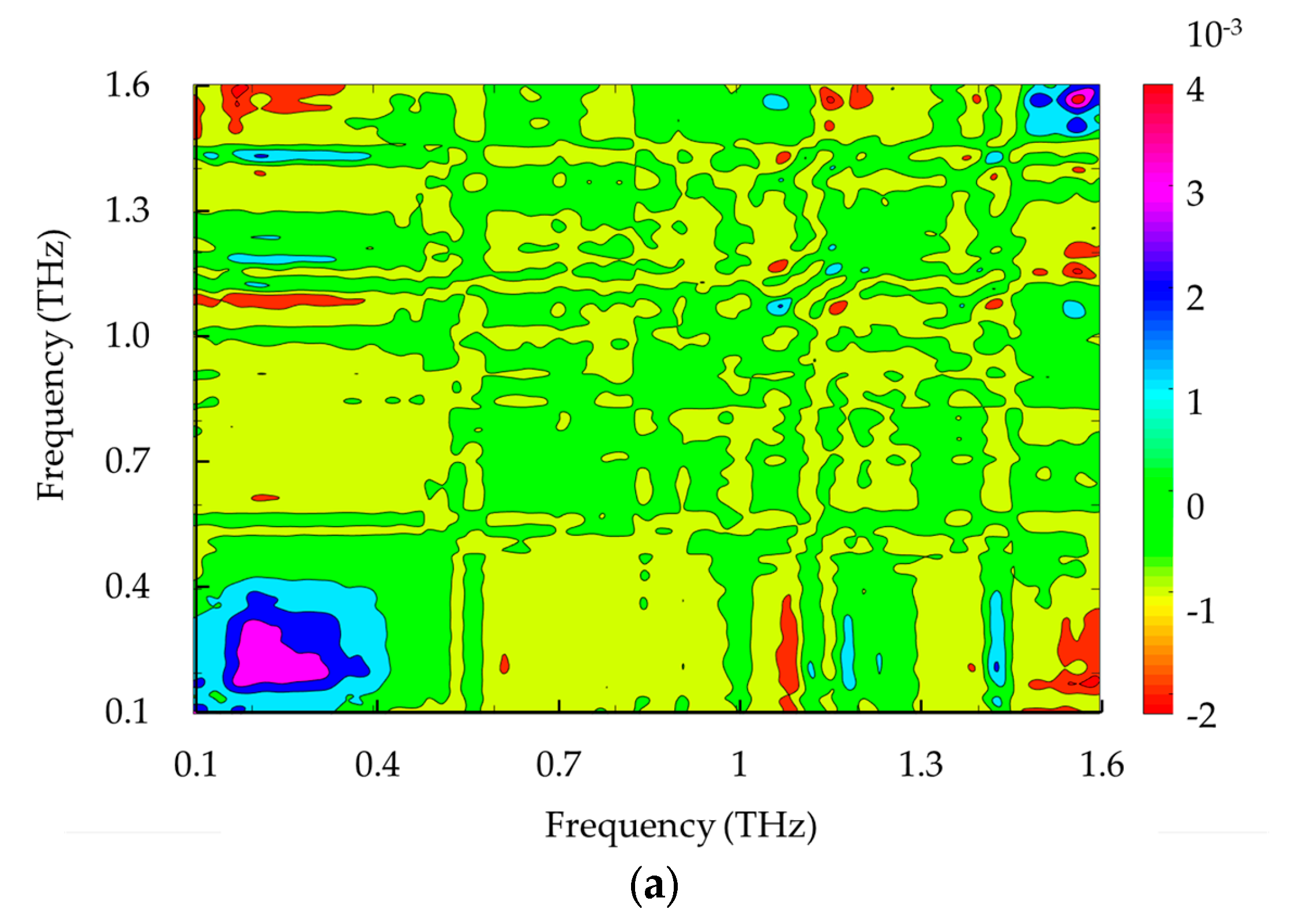

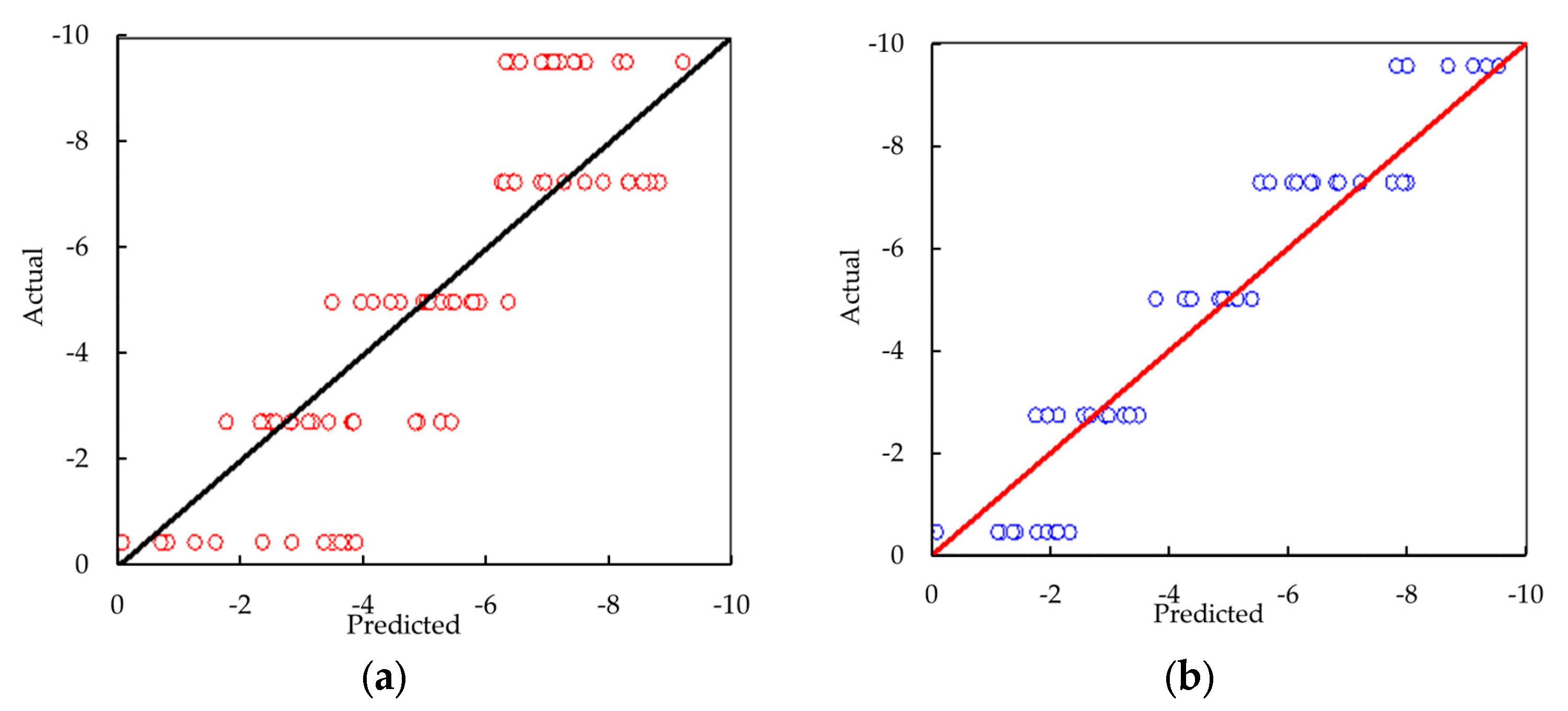


| Measurement Types | Dimension Conditions | Dimension Values | |
|---|---|---|---|
| Input dimension parameter of the background measurements | X | Y | |
| Reference offset (mm) | 0.0 | 0.0 | |
| Input dimension parameter of the sample measurements | X | Y | |
| Scan offset (mm) | 10.0 | 10.0 | |
| Measurement offset (mm) | 1.0 | 1.0 | |
| Coarse measurement step (mm) | 1.5 | 1.5 | |
| Measurement count (mm) | 10 | 10 | |
| Coarse/fine mode | coarse | ||
| Measurement conditions | Frequency resolution (GHz) | 3.8 | |
| Calculated number | 32 | ||
| Calculation range start (THz) | 0.3 | ||
| Calculation range stop (THz) | 4 | ||
| Sample thickness (mm) | 1 | ||
| Analysis type | All responses | ||
| NO. | Model | RAI | RMSEAI | R2D | RMSE2D |
|---|---|---|---|---|---|
| 1 | All samples | 0.7477 | 0.6038 | 0.7873 | 0.6032 |
| 2 | Removed, 0 °C-1; −2.5 °C-1; −7.5 °C-1; and −10 °C-1 | 0.7691 | 0.5962 | 0.8305 | 0.5763 |
| 3 | Removed, 0 °C-1; −2.5 °C-2; −5 °C-1; −7.5 °C-1 and −10 °C-1 | 0.8974 | 0.5797 | 0.9103 | 0.5221 |
Disclaimer/Publisher’s Note: The statements, opinions and data contained in all publications are solely those of the individual author(s) and contributor(s) and not of MDPI and/or the editor(s). MDPI and/or the editor(s) disclaim responsibility for any injury to people or property resulting from any ideas, methods, instructions or products referred to in the content. |
© 2023 by the authors. Licensee MDPI, Basel, Switzerland. This article is an open access article distributed under the terms and conditions of the Creative Commons Attribution (CC BY) license (https://creativecommons.org/licenses/by/4.0/).
Share and Cite
Lu, Y.; Asante, E.A.; Duan, H.; Hu, Y. Quantitative Assessment of Cold Injury in Tea Plants by Terahertz Spectroscopy Method. Agronomy 2023, 13, 1376. https://doi.org/10.3390/agronomy13051376
Lu Y, Asante EA, Duan H, Hu Y. Quantitative Assessment of Cold Injury in Tea Plants by Terahertz Spectroscopy Method. Agronomy. 2023; 13(5):1376. https://doi.org/10.3390/agronomy13051376
Chicago/Turabian StyleLu, Yongzong, Eric Amoah Asante, Hongwei Duan, and Yongguang Hu. 2023. "Quantitative Assessment of Cold Injury in Tea Plants by Terahertz Spectroscopy Method" Agronomy 13, no. 5: 1376. https://doi.org/10.3390/agronomy13051376
APA StyleLu, Y., Asante, E. A., Duan, H., & Hu, Y. (2023). Quantitative Assessment of Cold Injury in Tea Plants by Terahertz Spectroscopy Method. Agronomy, 13(5), 1376. https://doi.org/10.3390/agronomy13051376









